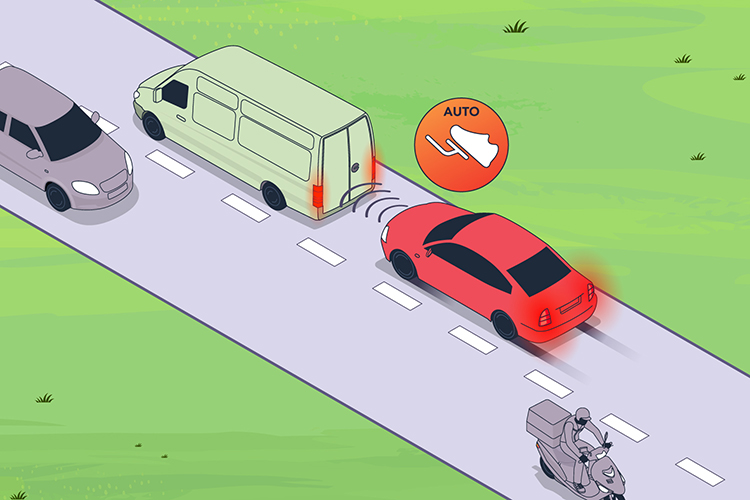How this technology works
Automatic emergency braking systems use sensors to detect obstacles in a vehicle's path. These braking systems can sense a potential collision with obstacles ahead and automatically apply the brakes to reduce the severity of the collision or avoid it entirely. Some more advanced systems may also detect pedestrians, cyclists, or large animals.
When the system detects an obstacle such as a stopped vehicle, it may activate braking to reduce the car's speed or bring it to a stop.
Automatic emergency braking is often paired with a feature called forward collision warning. Forward collision warning systems scan the road ahead while you drive, and will warn you if you're about to hit another vehicle or object. If you don't react to the warning in time, the automatic emergency braking system may engage to quickly slow down your car, or may even bring your car to a stop.
Description
A car’s sensors detect a stopped van immediately in front and the car brakes.
Operation
Automatic emergency braking is an active safety system that is enabled without driver intervention. Systems can be switched off at times but they will be automatically activated again the next time the vehicle is started. Drivers can override the automatic braking actions (for example, by applying torque to the steering wheel).
Other names for this technology
- Active braking
- Active safe
- Autonomous emergency braking
- Collision mitigation
- Forward collision mitigation system
- Forward emergency braking
- Front automatic braking
- Full auto brake
- Intelligent brake assist
- Intelligent braking
- Pre-collision assist
- Pre-collision braking
- Pre-collision system
- Pre-crash warning and braking system
- Pre sense front
- Smart brake support
Things for drivers to keep in mind
- Automatic emergency braking systems are designed to help you drive. They don't replace your attention and judgement
- You should always keep a safe speed and following distance from the traffic ahead, and stay focused on the road
- Automatic emergency braking may sense slow or stopped traffic ahead and suddenly apply the brakes
- This may not always prevent a collision, but may make one less severe
- Once your vehicle stops completely, it may continue moving forward slowly, even if the object is still in front
- The system may not work in all traffic, weather, and road conditions (like in heavy rain or snow, dense fog or strong sunlight, at night, or on curved roads)
- The system should not activate under normal driving situations
- Don't depend on this technology to avoid collisions. It is only for situations when you can't avoid a collision
- Some automatic emergency braking systems can detect vehicles, pedestrians, cyclists, or large animals
- This system may be limited to city or highway speeds, make sure you know what the operating speed range is for your vehicle
- You should read your owner's manual to learn about your vehicle's system, including its capabilities and limitations
